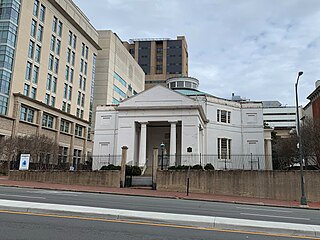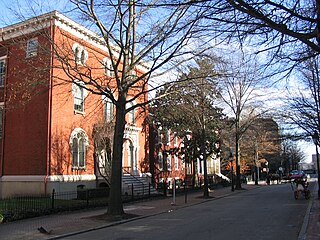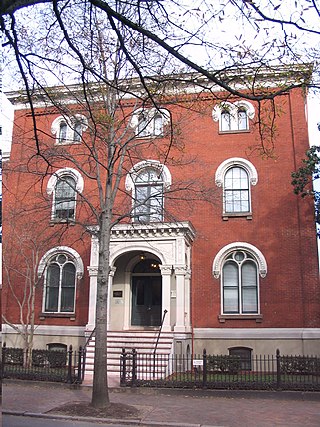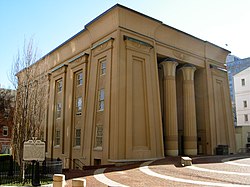
Virginia Commonwealth University (VCU) is a public research university in Richmond, Virginia. VCU was founded in 1838 as the medical department of Hampden–Sydney College, becoming the Medical College of Virginia in 1854. In 1968, the Virginia General Assembly merged MCV with the Richmond Professional Institute, founded in 1917, to create Virginia Commonwealth University. In 2022, more than 28,000 students pursued 217 degree and certificate programs through VCU's 11 schools and three colleges. The VCU Health System supports health care education, research, and patient care. It was the only school in the South to have graduated a class every year during the Civil war.

Hampden–Sydney College (H-SC) is a private liberal arts men's college in Hampden Sydney, Virginia. Founded in 1775, Hampden–Sydney is the oldest privately chartered college in the Southern United States, the tenth-oldest college in the US, the last college founded before the American Declaration of Independence, and the oldest of only three four-year, all-male liberal arts colleges remaining in the United States. Hampden–Sydney College is listed on the National Register of Historic Places and the Virginia Landmarks Register. It is affiliated with the Presbyterian Church (USA).

First Baptist Church is a historic Baptist church in Richmond, Virginia, United States. Established in 1780, the church is located on the corner of Monument Avenue and Arthur Ashe Boulevard. As of 2024 the senior minister is the Rev. Dr. Jim Somerville, former pastor of the First Baptist Church of Washington, D.C. Its historic building at 12th and East Broad streets is the home of Virginia Commonwealth University's Hunton Student Center.

Monumental Church is a former Episcopal church at 1224 E. Broad Street between N. 12th and College streets in Richmond, Virginia. Designed by architect Robert Mills, it is one of America's earliest and most distinctive Greek Revival churches. It is listed on the National Register of Historic Places, has been designated as a National Historic Landmark and is located in the Court End historic district.

Court End is a neighborhood in Richmond, Virginia, that sits to the north of the Capitol Square and East Broad Street. It developed in the Federal era, after Virginia's capital moved from Williamsburg.

Sabine Hall is a historic house located near Warsaw in Richmond County, Virginia. Built about 1730 by noted planter, burgess and patriot Landon Carter (1710–1778), it is one of Virginia's finest Georgian brick manor houses. Numerous descendants served in the Virginia General Assembly. It was added to the National Register of Historic Places in 1969, and declared a National Historic Landmark in 1970. At the time of its National Register listing, it was still owned by Carter / Wellford descendants.

The Old Medical College Building is a historic academic building at 598 Telfair Street in Augusta, Georgia, US. It was built in 1835 for the Medical College of Georgia, then and now one of the leading medical schools of the American South. It was declared a National Historic Landmark in 1996 for its sophisticated Greek Revival architecture, and for the role the school played in the establishment of the American Medical Association and the standardization of medical practices.

The William H. Grant House, also known as Sheltering Arms Hospital, is a historic house located in Richmond, Virginia. It was built in 1857, and is a large, three-story brick townhouse in the Italianate style. It features a small, richly ornamented arched front porch supported by coupled square columns. In 1892, the house was acquired by the Sheltering Arms Hospital, who occupied it until 1965. It is connected to the Benjamin Watkins Leigh House.

The Virginia Commonwealth University School of Medicine is the medical school of Virginia Commonwealth University, a public research university in Richmond, Virginia. It is the largest and oldest continuously operating medical school in Virginia. The school traces its beginnings to the 1838 opening of the medical department of Hampden–Sydney College, which in 1854 became an independent institution known as the Medical College of Virginia (MCV). In 1968, MCV joined with the Richmond Professional Institute to form Virginia Commonwealth University. The School of Medicine is one of six schools on VCU's MCV Campus, which includes the VCU Medical Center and Children's Hospital of Richmond at VCU.

The VCU Medical Center is Virginia Commonwealth University's medical campus located in downtown Richmond, Virginia, in the Court End neighborhood. VCU Medical Center used to be known as the Medical College of Virginia (MCV), which merged with the Richmond Professional Institute in 1968 to create Virginia Commonwealth University. In the 1990s, the Medical College of Virginia Hospitals Authority was created to oversee MCV Hospitals. In 2004, the name of this authority was changed to the VCU Health System, and the MCV Hospitals and surrounding campus were named the VCU Medical Center. The authority oversees the employees and real estate occupied by the five schools within the VCU Medical Center. It was at this time that the MCV Campus moniker was created.

The Cathedral of the Sacred Heart in Richmond, Virginia, is the seat of the Roman Catholic Diocese of Richmond. The property is located along North Laurel Street at 823 Cathedral Place, facing Monroe Park one block north of Main Street. Construction of the cathedral was begun in 1903, financed by donations of Thomas Fortune Ryan and his wife; it was the only cathedral at that time known to be constructed by the exclusive patronage of a single family.

Cushing Hall (1824) is a dormitory at Hampden–Sydney College in southside Virginia. Built in sections from 1822–1833, Cushing Hall is the oldest four story dormitory still in use in the United States. The building is listed in the Virginia Landmarks Register (1969) and on the National Register of Historic Places (1970) as a contributing property of Hampden–Sydney College Historic District. The structure is named after Jonathan P. Cushing, the fifth president of the college.
The history of Virginia Commonwealth University began in 1838, when the Medical College of Virginia was founded. In 1967 the Medical College of Virginia and the Richmond Professional Institute merged to become one, single university in Richmond, Virginia. Five presidents have served the institution since its merger and creation. VCU's medical school is the oldest continually operating medical school in the South; it created the first school of Social work in the South; and it is has the only school of dentistry in Virginia

Venable Hall is a dormitory at Hampden–Sydney College in southside Virginia. Built in sections from 1824 to 1830, Venable Hall is the second oldest dormitory on Hampden–Sydney's campus. The building is listed in the Virginia Landmarks Register (1969) and on the National Register of Historic Places (1970) as a contributing property to Hampden–Sydney College Historic District.
Founded in 1974, VCU Massey Comprehensive Cancer Center is a non-profit organization part of Virginia Commonwealth University. Located in Richmond, Virginia, Virginia Commonwealth University is one of the nation's top research universities, and VCU Medical Center, a leading academic health system ranked Virginia's top hospital by U.S. News & World Report in 2012.

The George Mason–VCU rivalry is a college sports rivalry between the VCU Rams of Virginia Commonwealth University and the George Mason Patriots of George Mason University. Both universities are present members of the Atlantic 10 Conference, and for a majority of their rivalry history, members of the Colonial Athletic Association.

Scott House, also known as Frederic W. Scott House and Scott-Bocock House, is a historic home located in Richmond, Virginia and is owned by Virginia Commonwealth University as the University's alumni house. The first floor of the historic house is available for university, community and corporate events. Many affairs — including university and alumni receptions and retreats — have occurred at the Scott House since its doors opened in the fall of 2004.

Richmond Academy of Medicine is a historic medical library building in Richmond, Virginia. It was built in 1931–32, and is a two-story, five bay square, brick and concrete Georgian Revival style building. The building features an elaborately-designed entry with a large broken pediment and a cartouche bearing a caduceus. The building houses a library, dining room, auditorium, and offices. It was designed specifically to house what once was a regionally significant collection of early medical manuscripts, art work, instruments and incunabula.
Gustave A. Sedon, also known as Gustavus Sedon, was a carpenter and craftsman in nineteenth century Roanoke, Virginia. He is noted for his work on various public buildings, plantation homes, and university structures. Sedon is known primarily for his ornamental work on buildings, many of which are now listed on the National Register of Historic Places.
Jean Louise Harris was an American physician and politician. The first black woman to graduate from the Medical College of Virginia, she went on to serve on the faculty there before being appointed Virginia Secretary of Human Resources by Governor John N. Dalton. Harris moved to Minnesota, where she ran in the Republican primary for lieutenant governor in 1990 and eventually for mayor of Eden Prairie. She was mayor until her death from lung cancer in 2001.





















